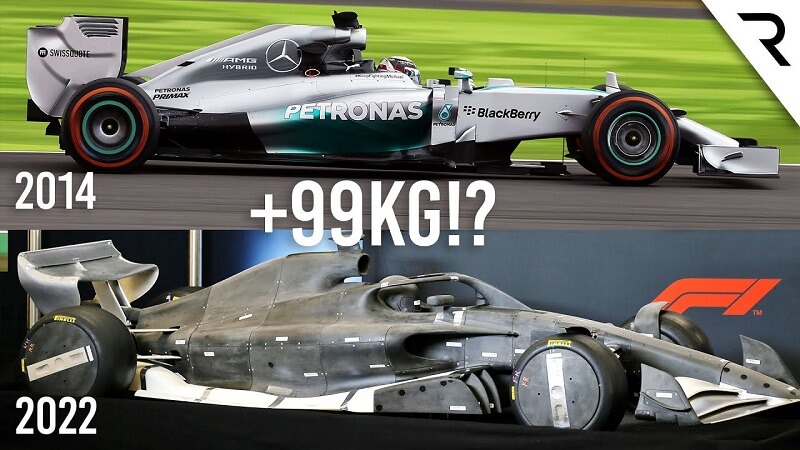How much does an f1 car weigh? How much does a formula 1 car weigh? The weight of a car is significant in Formula One. Over the years, the car’s weight has been increasing. Today’s Formula One car are the heaviest in the history of the sport. This is due to the additional parts in the car, especially for safety concerns.
The weight of a Formula One car varies during a Grand Prix weekend. While this is up to the team, they must follow the minimum weight requirement set by the FIA. The technical regulations are quite lengthy. The teams must comply with the weight rules. The technical rules change every season.

How much does an f1 car weigh?
In total, 798kg (1,759 lbs), which is 3kg up from the original limit of 795kg which teams apparently struggle to meet. Interestingly, there was in fact a plan to reduce the weight by 2kg, but it was axed in order to accommodate the addition of heavier tires and mandated electronic devices in the car.
To be frank, weight counts for everything in the world of Formula 1, but surprisingly cars have been getting heavier over time. In 2023, cars are heavier than they’ve ever been in the history of the sport and this is largely due to the addition of safety features like the halo which weighs 7kg. It’s also worth noting that during a grand prix weekend the weight of the car can fluctuate immensely. This of course has led to the FIA setting a minimum weight for the cars which teams must attain.
To be clear, the stated weight pertains to the car with a driver seated, fitted with dry-weather tires and no fuel. As you can probably guess, each team’s car goes over this weight in varying amounts. To date, Alfa Romeo is said to be the only team that isn’t overweight, which is probably why they were directly opposed to the idea of increasing the minimum weight. Where the dimensions of the car are concerned, it’s interesting to note that while there is no maximum length the car can be no more than 200cm wide and 95cm tall.

How much does an F1 driver weigh?
With the shortest, driver Yuki Tsunoda, being 5’2” and tallest drivers, Alex Albon and Esteban Ocon, both being 6’1”, there is no surprise that weight fluctuates between all the drivers. However, FIA rules state a minimum weight for an Formula 1 driver of 80kg.
If the driver weighs less than 80kg (which is the vast majority of drivers) then this difference is corrected with ballast. This ballast is added to the cockpit so it cannot be placed anywhere on the car to improve balance. This figure also includes the driver’s helmet, race suit and shoes so drivers do not aim to weigh exactly 80kg.
This 80kg minimum rule was implemented in 2019 to reduce the advantage shorter and lighter drivers had. Before this rule, the driver weight was included holistically within the overall F1 car weight rules which meant lighter drivers provided teams with more room to improve the balance of the car. Before that, it was not uncommon for drivers to be told the specific weight they were allowed to be by their teams, and this was often lower than what was healthy for the drivers.
So, here’s a table of the F1 drivers’ weights.
| Driver | Weight |
| Alex Albon | 74kg (163lbs) |
| Lewis Hamilton | 73kg (161lbs) |
| Nicholas Latifi | 73kg (161lbs) |
| Max Verstappen | 72kg (159lbs) |
| George Russell | 70kg (154lbs) |
| Pierre Gasly | 70kg (154lbs) |
| Lance Stroll | 70kg (154lbs) |
| Charles Leclerc | 69kg (152lbs) |
| Valtteri Bottas | 69kg (152lbs) |
| Kevin Magnussen | 68kg (150lbs) |
| Lando Norris | 68kg (150lbs) |
| Fernando Alonso | 68kg (150lbs) |
| Mick Schumacher | 67kg (148lbs) |
| Esteban Ocon | 66kg (145.5lbs) |
| Daniel Ricciardo | 66kg (145.5lbs) |
| Carlos Sainz | 64kg (141lbs) |
| Guanyu Zhou | 63kg (139lbs) |
| Sergio Perez | 63kg (139lbs) |
| Sebastian Vettel | 62kg (137lbs) |
| Yuki Tsunoda | 54kg (119lbs) |
Why do drivers get weighed after a race?
Drivers are weighed after the race for two reasons – one is to measure how much weight a driver has lost during the race, and the other is to ensure that the driver and car still meet the minimum weight limit.
Drivers lose around 2-3kg a race, even more in hotter conditions, so they are weighed to understand exactly how much weight they have lost so fluids can be replenished and subsequent training programmes for the next week are informed by any dramatic weight loss. Secondly, as the minimum mass of the Formula 1 car includes the driver, their weight needs to be known so that when the car is weighed the two figures can be added up to ensure the teams have reached that minimum amount.
The drivers are weighed with their full race gear, including helmets, as this is included in the weight of the driver, and this means the FIA can calculate that the correct amount of ballast has been added if necessary.

How much do F1 parts weigh?
While the entire F1 car should weigh no less than 798kg, the heaviest part of a Formula 1 car is the engine which must weigh a minimum of 150kg, whereas the lightest part is the steering wheel which weighs 1.3kg. Some parts have minimum weight requirements listed in the rulebook, whereas others are free for teams to make as light as possible.
| Part | Weight |
| Engine | Minimum 150kg |
| Fuel | Maximum 110kg |
| Front wing | Around 10kg |
| Chassis/Monocoque | No set weight |
| Halo | 7kg |
| Gearbox | Around 40kg |
| Steering wheel | Around 1.3kg |
F1 weight through the years
The 2022 cars are now comfortably the heaviest in the history of F1, and this is largely the result of safety regulations that have mandated the inclusion of safety features such as the halo. The banning of refuelling also contributed to larger, and therefore heavier cars.
| Year | Weight | Changes |
| 2008 | 585kg | |
| 2009 | 605kg | |
| 2010 | 620kg | Refuelling is banned |
| 2011 | 640kg | Kinetic Recovery System (KERS) widely adopted |
| 2012 | 640kg | |
| 2013 | 642kg | Minor changes in the weight of Pirelli’s tyre range |
| 2014 | 691kg | Hybrid V6 engines introduced |
| 2015 | 702kg | Anti-intrusion panels added to cockpit |
| 2016 | 702kg | |
| 2017 | 728kg | Wider wheels and tyres introduced |
| 2018 | 734kg | Halo introduced |
| 2019 | 743kg | 80kg driver allowance |
| 2020 | 746kg | Second fuel flow meter added |
| 2021 | 752kg | |
| 2022 | 798kg | New cars designed around ground effects aerodynamics, plus bigger wheels and wheel covers also introduced |
How heavy is an F1 car engine?
The minimum weight of an F1 car engine is 150kg. This is the weight of the internal combustion engine (ICE), the energy recovery system (ERS), and all of the associated components. The ICE is the heaviest part of the engine, and it typically weighs around 120kg. The ERS is the second heaviest part, and it typically weighs around 30kg. The remaining components, such as the fuel system and the cooling system, typically weigh around 10kg.
The weight of the engine is a major factor in the overall weight of the car. Teams are always looking for ways to reduce the weight of the engine, as this can give them a competitive advantage. In recent years, there have been a number of technological advancements that have helped to reduce the weight of the engine. For example, the use of lighter materials, such as carbon fiber, has helped to reduce the weight of the ICE. Additionally, the development of more efficient ERS systems has helped to reduce the overall weight of the engine.
The weight of the engine is also a safety factor. The heavier the engine, the more energy it takes to stop the car in an emergency. This is why the minimum weight of the engine is set by the FIA. The FIA wants to ensure that the cars are safe, and they believe that a minimum weight of 150kg is necessary to ensure that the cars can be stopped safely.
FAQs
How much does a current F1 car weigh?
The minimum weight of a current F1 car is 798kg (1,759 lbs), including the driver. The weight of the car can vary depending on the fuel load, but it is typically around this weight. The heaviest part of an F1 car is the engine, which must weigh a minimum of 150kg. The lightest part is the steering wheel, which weighs 1.3kg.
The weight of an F1 car has been increasing in recent years due to the addition of safety features, such as the halo. However, there are plans to reduce the weight of the cars in the future. This will be done by using lighter materials and by making the cars more efficient.
How heavy is an F1 car at full speed?
The weight of an F1 car does not change at full speed. The car’s weight is determined by the amount of fuel it is carrying, and the amount of fuel does not change as the car goes faster. However, the weight distribution of the car may change at full speed. As the car goes faster, the downforce increases, which pushes the car down onto the track. This causes the weight distribution to shift forward, as the front tires are bearing more of the weight of the car.
The weight of an F1 car is a critical factor in its performance. The lighter the car, the faster it can go. However, the weight of the car must also be high enough to ensure that it is safe. The FIA sets a minimum weight for F1 cars, and teams must ensure that their cars meet this weight requirement.
In 2023, the minimum weight of an F1 car is 798kg (1,759 lbs). This includes the weight of the car, the driver, and the fuel. The maximum fuel load for an F1 car is 105kg. This means that the maximum weight of an F1 car at full speed is 893kg (1,967 lbs).
However, it is rare for F1 cars to run with a full fuel load. Most teams will start a race with a fuel load of around 85kg, which means that the car’s weight at full speed will be around 883kg (1,946 lbs).
Above is information about How much does an f1 car weigh? that we have compiled. Hopefully, through the above content, you have a more detailed understanding of Why do drivers get weighed after a race? Thank you for reading our post.









